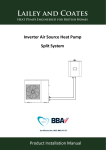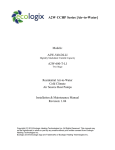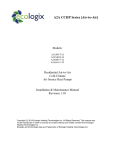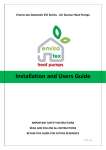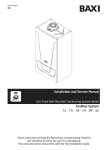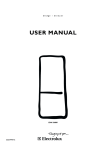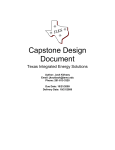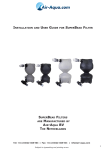Download 2014 Installation Manual 4 Aug 14
Transcript
Lailey and Coates Heat Pumps Engineered for British Homes Inverter Air Source Heat Pump Split System Product Installation Manual Inverter Air Source Heat Pump Split System 2 Installation Manual 2014 - Riv 2 Contents General Information..............................................................................................5 Technical Specification ..........................................................................................6 Installation of External Unit...................................................................................7 Installation of Internal Unit...................................................................................8 Wiring Instructions................................................................................................9 Rated power input and fuse information............................................................10 Indoor Electrical Connections..............................................................................11 Plumbing Installation...........................................................................................12 Refrigeration Installation.....................................................................................14 Dip Switch Settings..............................................................................................16 Pre-Operation Checklist.......................................................................................17 Commissioning ..................................................................................................18 LCD controller......................................................................................................19 How to set up LCD controller...............................................................................20 Setting the Hot Water Temperature....................................................................21 Setting the Heating Water Temperature..............................................................22 Setting the Heat Pump Timer..............................................................................23 Holiday Timer......................................................................................................26 Simple Trouble Shooting Guide.........................................................................27 Access to change system parameters..................................................................27 Fault / Error Codes...............................................................................................30 Commissioning Sheet..........................................................................................34 3 Installation Manual 2014 - Riv 2 Thank you for purchasing a Lailey and Coates Air source Heat Pump. Please read this manual carefully before installation and operation. It contains important information to enable a safe and successful installation. If you have any queries please ring our Technical Helpline on 01753-537830 before running the Heat Pump. Safety Instructions To prevent injury/damage to persons or property the following instructions should be followed at all times: · This product should only be installed by Approved Lailey and Coates partners. All installation engineers should be suitably qualified and made aware of the contents of this manual. · Repairs and Maintenance should be carried out by Approved Lailey and Coates partners to ensure validity of Warranty. · Internal and external units should be securely fixed to solid surfaces ensuring a minimum support weight of 20g/mm2. · All local regulations, by-laws and standards should be checked and adhered to at all times. · Internal and External Units should be installed as per guidelines in this manual ensuring adequate ventilation and airflow around the units. · Care should be taken when cleaning/installing product so as to avoid water ingress, electric shock or damage to unit and associated pipework and cables. Both internal and External units should be isolated for these purposes. · This product has been designed for use by persons with experience of Heating controls and as such should not be operated by children or persons with reduced physical, sensorial or mental faculties unless supervised by a responsible person. Installation Manual 2013 Riv 2 4 General Information The Lailey and Coates Split System consists of two major parts: The Internal and External Units. They are connected via refrigeration pipes and an ELV, shielded, communication Cable. The external units can either be wall mounted or hard-standing but should be secured via suitably designed mounting systems available from Lailey and Coates. When siting the outdoor unit it is essential that an adequate, un-restricted level of airflow is available to ensure correct operation and maximum efficiency of the system. See page 7. The Internal Unit is designed to be wall mounted in a suitably dry position. The Lailey and Coates Split System will accommodate all your heating and hot water demands and is suitable for use with; under floor Heating, Radiators and Fan Coil Units. The system is integrated with an Electrical Heater for extreme weather conditions and also acts as a backup if there is a problem with the External Unit. Model identification LC - 15 Model Type Lailey and Coates 5 Installation Manual 2014 - Riv 2 Unit Size Nominal Heating Capacity = 15 kW Technical Specification Outdoor Unit LC-07 Power supply LC-10 LC-12 LC-15 220-240v 50 Hz Nominal capacity * Heating kW 6.93 9.68 12.67 15 Nominal input * Heating kW 1.43 2.05 2.73 3.33 COP * 7⁰C (A7/W35) Heating kW 4.84 4.73 4.64 4.5 Min ⁰ C -15 -15 -15 -15 Max ⁰ C 35 35 35 35 Diameter ins ½ - �⁄� �⁄� - �⁄� ¾ - �⁄� ¾ - �⁄� R 410 a R 410 a R 410 a R 410 a Outdoor temperature range Refrigerant pipe diameter Refrigerant Type Compressor Rotary DC compressor Fan Speed Variable Heater mats fitted Sound pressure level Heating Maximum pipe run (indoor to outdoor unit) Maximum Yes Yes Yes Yes dBA 48 50 51 52 m 15 20 20 25 Piping connections (flow and return) Dimensions outdoor unit Weight � �⁄� " (female) Height mm 892 892 1250 1250 Width mm 963 963 963 963 Depth mm 342 342 343 343 Gross Kg 105 108 118 120 Net Kg 89 92 101 103 LC-07 LC-10 LC-12 LC-15 Indoor unit Dimensions indoor unit Weight Height mm 549 549 609 609 Width mm 450 450 450 450 Depth mm 262 262 262 262 Gross Kg 35 36 39 40 Net Kg 30 31 34 35 dBA 26 27 28 29 ⁰ C 55 55 55 55 L / min 12 18 24 30 ⁰ C 55 55 55 55 4 kW 4 kW Sound pressure level Water flow temperature Heating max Minimum water flow Pump heat at min flow Electrical Heaters Power Supply W Capacity kW 220-240v 3 kW 3 kw * Ta DB /WB 7⁰C / 6⁰C LWC 35⁰C ∆T 5⁰ C as per EN 14511 Installation Manual 2013 Riv 2 6 Installation of External Unit When locating the External Unit the following considerations should be taken into account: ● If wall mounting ensure that the structure is sufficiently solid to bear the weight of the unit without causing vibration. ● If floor mounted ensure base is solid with no likelihood of subsidence. ● Select a location so as to minimise disruption to neighbours and avoid close proximity to bedrooms. In accordance with MCS standards. ● Ensure adequate access to and around the unit for maintenance and non‐ restriction of airflow. ● Close proximity to possible gas leaks or electrical equipment should be avoided. ● When in defrost excess water will drain from the unit so ensure an adequate method of disposal to same. Air Flow Restrictions: ● Provide a front clearance of minimum 4000mm. ● To sides and rear clearance of minimum 170mm. Please note: Floor and Wall mounting brackets are available from Lailey and Coates on request. A wall mounting template is supplied with the External Unit. 7 Installation Manual 2014 - Riv 2 Installation of Internal Unit When locating the Internal Unit the following considerations should be taken into account: ● If wall mounting ensure that the surface is flat, non‐combustible and sufficiently solid to bear the weight of the unit without causing vibration. ● Provision should be made for sufficient access to ensure ease of maintenance. ● Ensure the unit is not exposed to extremes of temperature. ● Avoid close proximity to possible inflammable gas leakage. ● Maximum refrigeration pipe length See page 13 Please note: a wall bracket and mounting template are supplied with the Internal Unit. 8 Installation Manual 2014 - Riv 2 Wiring Instructions Warnings This unit must be installed to conform with all relevant local standards and regulations by suitably qualified engineers. This unit must be earthed. Please ensure this unit has a suitable, dedicated power supply/supplies, and is not susceptible to frequent power loss via time clocks or other devices, etc. Suitably rated and protected cables should be used. Isolators should be double pole. Isolate both units during maintenance and repairs. Power Input and Communication Cables: 3 Core Cable from MCB LNE Suitably Rated Internal Isolator 3 Core 0.75mm screened AGB terminals 3 Core Cable from MCB LNE Suitably rated weather-proof isolator Installation Manual 2013 Riv 2 9 Rated power input and fuse information Model Rated Outdoor Unit Indoor Unit Max Fuse Rating Amps Combined System Watts Max Current Amps Max Fuse Rating Amps Watts Max Current Amps Max Fuse Rating Amps Hz Volts Watts Max Current Amps LC 07 50 220-240 3300 14 16 3054 14.4 16 6354 28.4 32 LC 10 50 220-240 4900 21 32 3054 14.4 16 7954 35.4 40 LC 12 50 220-240 6000 26 32 4054 17.4 20 10054 43.4 50 LC 15 50 220-240 6800 29 32 4054 17.4 20 10854 46.4 50 Please note: ● Indoor unit load includes backup heater but not pump (54W rating). ● Indoor and outdoor units can be supplied separately or on one dedicated supply but slave unit should be suitably fused down. ● Shielded heat resistant cable to be installed on ELV cables. ● 300mm spacing should be ensured between unshielded 230V and all ELV cables where practicable. ● LC 12KW and LC 15KW External Units should be supplied via motor rated M.C.B’S. On completion of Electrical Installation please ensure the following: ● 230V and ELV cables are suitably connected in appropriate connection blocks. ● Dip switches to both Internal and external units are correctly set. See page 15 ● ELV connections 7/8, 9/10, 11/12 are linked out if unused. ● Electric heater switch in Internal Unit (where applicable) is switched ‘on’. 10 Installation Manual 2014 - Riv 2 Indoor Electrical Connections 230 v Switching Only 15 Hot Water ‘On’ To Zone Valve (unsuitable for mid-position type) 14 Neutral 13 Heating ‘On’ To Zone Valve (unsuitable for mid-position type) 12 11 10 9 8 7 6 5 4 3 2 1 Solar Pump Secondary Hot Water Pump if Required 2 - Port Valve - (Cooling option only. Not required) Secondary Heating Pump if Required Water Cylinder Electrical Heater (Immersion for Legionella) Boiler (not Required) Volt Free / 0 - 10 Volt Switching Only (NO MAINS POWER) 15 B 14 G Interconnecting Cable between Indoor and Outdoor Unit (A,B,G) 13 A 12 11 10 9 8 7 6 5 4 3 2 1 Cylinder Temperature Control Switch - High Limit Stat (link if not used) Water Flow Switch if Fitted (link if not used) Volt Free ON/OFF Signal - Heating On/Off (link if not used) 0-10V Temperature Control Signal Solar Temperature Sensor Water Cylinder Temperature Sensor - Hot Water On/Off Installation Manual 2013 Riv 2 11 Plumbing Installation Warnings This unit must be installed to conform with all relevant local standards and regulations by suitably qualified engineers. Installation should be capable of withstanding a maximum water pressure of 10 bar. Mid-position zone valves should not be used to switch between heating and hot water. Hydraulic zone valves are not suitable for use with this system. Water quality should conform with EN directive 98/83 EC. To avoid possible damage to Electrical components please ensure a suitable means of drainage is available for the pressure relief valve. If the Heat Pump is being installed as a retro-fit please ensure system is fully flushed to avoid damage to Internal Unit. Heating Schematic Typical Y-Plan Configuration 1 Typical S-Plan Configuration No 230v 3-Port Valve. 2 No 230v 2-Port Valves. NOT mid position type ( i.e. switched to heating or hot water NOT both) Minimum Water Flow Rates 12 Unit Size LC 07 LC 10 LC 12 LC 15 Litres/Min 12 18 24 30 Installation Manual 2014 - Riv 2 Plumbing Installation Continued Internal Pump Settings ● If used with radiators, pump should be set to AUTO ● If used with under floor heating, pump should be set to MANUAL and adjusted to Settings 1, 2 or 3 to achieve required flow rate as per table above. ● If a combination of radiators and under floor heating, pump should be set to manual as above. If the required flow rate is not achieved, an auxiliary pump can be fitted to either or both Central Heating and Hot Water and wired to 230 Volt connections on wiring block. Please Note: ● Zone valves should have a maximum changeover time of 60 seconds. ● Flow and return pipes are 1‐1/4’’ female. A male to female reducer can be used if necessary. ● To facilitate ease of maintenance isolating valves should be installed on flow and return pipes as close to the unit as possible. ● A flow meter should be installed to ensure correct flow rate (available from Lailey and Coates). ● Pipe connections can be made either to top or bottom of unit. ● A bypass should be installed to the Heating to facilitate an overrun of 1 minute to the internal pump. Prior to initial start-up please ensure following: ● All Air is purged from system (solar flush pump recommended on U/Floor Heating Systems). ● Automatic Air Purge Valve on unit is open. ● Water Pressure is at approximately 2 bar (this will need re‐pressurising as air is released from system). ● All valves are open. ● Back‐up Heater vessel is full. Installation Manual 2013 Riv 2 13 Refrigeration Installation. Warnings: This unit must be installed to conform with all relevant local standards and regulations by suitably qualified engineers. When brazing the pipe always use OFN. This unit is only suitable for R410A Refrigerant. This product contains fluorinated greenhouse gasses covered by the Kyoto Protocol. Do not vent gasses into atmosphere. Please ensure all pipework is lagged in accordance with current refrigeration standard. Precautions should be taken to prevent ingress of dirt etc into External and Heat Pump pipework. Failure to do so can cause Heat Pump failure. All systems are pre-charged to 5m Heat pump system refrigerant capacities are as follows: Unit Size LC 07 LC 10 LC 12 LC 15 R 410 A 1.8 kg 2.0 kg 2.8 kg 3.0 kg Please note: If the maximum pipe runs shown below are exceeded an extra refrigerant charge is required as follows: Refrigeration piping specification LC 07 LC 10 LC 12 LC 15 Maximum allowable piping length between out-door unit and indoor unit 15m 20m 20m 25m 5m 8m 10m 15m 35 g/m 65 g/m 65 g/m 65 g/m Suction Pipe Size 12.7mm (1/2”) 15.88mm (5/8”) 19.05mm (3/4”) 19.05mm (3/4”) Liquid Pipe Size 6.35mm (1/4”) 9.52mm (3/8”) 9.52mm (3/8”) 9.52mm (3/8”) Maximum allowable height difference between outdoor unit and indoor unit Additional refrigerant required for refrigerant pipe exceeding 5 m in length 14 Installation Manual 2014 - Riv 2 Refrigeration Installation Continued Please note: ● Refrigerant pipes can be connected to either the top or bottom of the unit. If using top connections ensure bottom connections are tight and vice-versa. ● Pre‐Pressure Testing and Commissioning, ensure Service valves are open and Schrader valves are fully closed. Precautions when adding R410A Be sure to charge the specified amount of refrigerant in liquid state to the liquid pipe. As R 410A is a mixed refrigerant, adding it in gas form may cause the refrigerant composition to change, preventing normal operation. Before charging, check whether the refrigerant cylinder is equipped with a siphon tube or not (the cylinder should be marked with “liquid filling siphon attached” or something similar. Charge the liquid Charge the liquid refrigerant with the refrigerant with the cylinder in an upright cylinder in up-side-down position position Be sure to use tools exclusively for R410A to ensure required pressure resistance and to prevent foreign materials from mixing into the system. NB Glasses and Gloves must be worn. Installation Manual 2013 Riv 2 15 Dip Switch Settings Both internal and external Units have a bank of PCB dip switches. These should be checked prior to initial start-up to ensure correct operation of the Heat Pump. Any changes to these settings should be carried out with the Heat Pump powered down to enable the PCB to recognise these changes. The settings are as follows: External Unit Heat Pump Model DS 1 DS 2 DS 3 DS 4 DS 5 DS 6 DS 7 DS 8 LC 07 On Off On On On Off Off Off LC 10 Off Off On On Off Off Off Off LC 12 On On On On On Off Off Off Lc 15 On On On On Off Off Off Off Internal Unit Volt Free : 1 ON, 2 OFF 1-10 Volts: 1 ON, 2 ON N.B. For Heat Pump operation ensure Electric Heater switch is ‘ON’. For Boiler operation turn switch to ‘Boiler’ (not applicable to all units). Backup Heater In the event of a system failure the back-up heater can be used to ensure continued hot water and central heating. The following procedure should be carried out to facilitate this option: LC12/LC15: To isolate inverter compressor set Dip Switch 3 to off. To isolate fixed speed compressor set Dip Switch 2 to off. LC7/LC10: 16 To isolate compressor and use backup heater set Dip Switch 3 to off. Installation Manual 2014 - Riv 2 Pre-Operation Checklist Prior to initial start-up please ensure following: General: Dip Switches are correctly set to both External and Internal Units. See page 15 There is no obvious damage to the body or components of the units. Units are securely fixed to walls/floor. Electrical: All cables are correctly terminated in appropriate connection blocks (i.e LV and ELV cables are not mixed up). All links to ELV control wiring are wired. Appropriate means of isolation and earthing have been installed. Protection devices and cables are correctly sized and undamaged. All terminations are secure. Electric Heater switch in Internal Unit (where applicable) is ‘ON’. Plumbing: Backup heater vessel is completely filled with water. Air purge valve is open (at least 2 turns). All shut-off valves are in place and in the open position. Refrigeration: System has been pressure tested for leaks. System contains correct refrigerant levels. Schrader valves are tight. Service valves are open. When the above checklist has been carried out and the pre-commissioning sheet is completed you are ready to run and commission the Heat Pump. Installation Manual 2013 Riv 2 17 Commissioning After the initial installation the system needs to be commissioned, this document will explain and show how to set up and commission an air to water heat pump. Stage 1 - Electrical Check that the system wiring is complete and connected properly before switching on the power to the indoor and outdoor unit. Ensuring that the isolators are switched off, check that all cables are secure, all terminals are tight and there are no bare ends exposed. Stage 2 - Refrigeration Pipework Before turning on the power and commissioning, you must ensure that the system has no leaks and has the correct refrigerant charge. If you are not the installation engineer please ensure that the pre –commissioning sheet is completed. Stage 3 - Setting up the Controller Switch on the power and set up the LCD controller on the indoor unit. See page 19 Stage 4 - Initial Start Up Once the LCD controller is set the system can now start. Press either the hot water or the heating icon on the LCD controller and the system will start. There is a 3 minute time delay before the compressor will start. Stage 5 - Commissioning Sheet Once the system is fully operational and the inverter is at maximum speed 85 Hz, compete the commission sheet by recording all data requested. A sample commissioning sheet can be found at the end of this document. Outdoor Unit 18 Indoor Unit 1 T emperature - Air on the coil 1 Water flow temperature / pressure 2 T emperature - Air off the fan 2 Water return temperature / pressure 3 Suction pressure / temperature 3 Water pump status 4 Discharge pressure / temperature 4 Back up heater function test 5 Liquid pressure / temperature 5 LCD controller status 6 Compressor running amps on each phase 7 Mains incoming amps 8 Fan speed settings Installation Manual 2014 - Riv 2 LCD controller Main Display Home Screen 1 Date Time and Day indicator 2 Timer Set Icon 3 System Error Code 4 Legionella Cycle Active 18/06/2014 15:32 SUN 5 Volt Free Indicator 6 Screen On / Off 19 Actual temperatures of heating and hot water 7 Status 8 Parameters 18 Required temperature settings for heating and hot water 9 Timers - See Page 10 Help 11 LCD Lock 17 Heating Indicator 12 Hot Water Boost 16 Defrost Indicator 13 Fault Indicator 15 Anti-Freeze Icon * 14 Hot Water * Not required on a split system unless the indoor unit is installed in an un-insulated outhouse again this will flash if anti-freeze is required How to set up LCD controller Setting the date, time and day. To access the time settings screen, touch the date, time and day indicator (1) on the controller home screen. 1 Date Time and Day indicator 09/02/2013 09:12 TUES The controller will bleep and the screen will change to the following : Time SetDate: 2013 Year 2 Mon 9 Day 12 Minu 9 Sec- Time 9 Hour Day of Tue OK Cancel Touching each of the numeric displays in turn, will allow you to adjust them to the desired setting, by using the keypad below, which will appear. Press enter to input and return to the time set screen 12 1 2 3 4 5 6 7 8 9 0 oo . Esc Clr Enter Once complete touch the OK icon. Check that the date, time and day indicators are now displaying the correct settings. 20 Installation Manual 2014 - Riv 2 Setting the Hot Water Temperature To set the hot water temperature, touch the ‘setting temperature’ as indicated. The controller will bleep and the screen will change to the following : 16 1 2 3 4 5 6 7 8 9 0 oo . Esc Clr Enter Enter the desired temperature and press enter. The display will revert to the home screen and the set temperature will be displayed. Installation Manual 2013 Riv 2 21 Setting the Heating Water Temperature To set the heating water temperature, touch the ‘setting temperature’ as indicated. The controller will bleep and the screen will change to the following , enter the default access code 112233, then press enter. 112233 1 2 3 4 5 6 7 8 9 0 oo . Esc Clr Enter The display will revert to the home screen. Touch the ‘setting temperature’ again, the display will change again, this time enter the temperature and press enter. Once again, the display will revert to the home screen, and the set temperature will be displayed. 22 Installation Manual 2014 - Riv 2 Setting the Heat Pump Timer From the main display home screen, touch the timer icon (9). The controller will beep and the screen will change as follows: Heating Hot Water Timer Set Indicator Holiday Timer Within this screen there are two display grids for days of the week, the upper one is for heating the lower for hot water. Touch and hold relevant day to access the timer settings for that day, the controller will beep and screen will change as follows: Please note that when the timers are set for each individual day, a green circle will be displayed to the left of the day. You can also access the holiday timer from this screen. Installation Manual 2013 Riv 2 23 Setting the Timer Continued Individual day timer screen - Heating Touch to close the screen IMPORTANT Touch to accept settings before closing this screen Within the individual day timer screen there are three pairs of on/off timers. In other words the system can be set to switch on and off three times during a 24 hour period. These can be set as follows: 1) Touch the hour side (left) of the relevant time indicator, this will allow adjustment of the hour by taking you to the following screen. 16 1 2 3 4 5 6 7 8 9 0 oo . Esc Clr Enter Using the 24 hour format enter the required hour. For example 16 for 4pm, the corresponding digits will appear, touch enter to accept. To adjust the minutes, repeat the process by touching the minute side (right), entering the minutes and touching enter. The correct time should then be displayed in set timer screen, touch the OK icon to confirm and accept the setting. NOTE: If you close the screen without touching OK your setting will be lost. Continued… 24 Installation Manual 2014 - Riv 2 Setting the Timer Continued 2) Once the time is set, select whether this is to start or stop the system by touching the corresponding power icon and selecting on or off. 3) The setting must then be enabled, to do this touch the enable icon and ensure that a green tick is visible. To disable, simple touch again so that a red cross appears. 1 2 on 3 Repeat this process for each of the timer settings and when you have finished touch the OK icon. Further repeat for each day of the week for heating, and then for hot water. Important: To accept your settings you must remember to touch the OK icon before you close the screen. To close touch the red cross on the top right of the screen. This will return you to the main timer screen, there should now see a green dot next to the day you have just set, this confirms that the timer is set accordingly. Installation Manual 2013 Riv 2 25 Holiday Timer To access the holiday timer touch the timer icon on the home screen. The daily timer screen will appear. Touch the Holiday icon and the holiday timer screen is displayed as below. 2013 / 99 / 99 Holiday Start : date Time 9999 / 99 / 99 hour 9999 / 99 / 99 hour When the green ‘ON’ icon is illuminated the timer is set. Clear Finish OFF ON To set the required holiday period, touch the relevant sections of the start date and enter the relevant digits using the following screen. 16 1 2 3 4 5 6 7 8 9 0 . oo Esc Clr Enter Press enter after completing each section. Repeat for all sections of start and finish date and time. Using the 24 hour format, select the hour to start and finish the holiday period. To reset and start again touch the clear icon. When you have completed your selections touch the red off icon, red to green ON OFF to indicate that the timer is set. Please note: The heat pump will not function between the set dates. 26 Installation Manual 2014 - Riv 2 this will turn from Access to change system parameters To gain access to the system parameters touch the parameters icon on the main home screen and the enter the following code 223344, followed by enter. Simple Trouble Shooting Guide This guide is to provide engineers a simple understanding of potential faults and how to rectify them. Lailey and Coates error / fault codes are listed in full on page 29 of this manual. High Pressure fault This Indicates that the Heat Pump system has exceeded the maximum pressures, set on the high pressure switch. Causes - In Heating Mode 1. 2. 3. 4. 5. 6. This may be due to blockage within the water pipes giving poor thermal transfer through the heat exchanger Over charged with refrigerant Non Condensable gas i.e. Nitrogen in the system Water Flow failure High on coil temperature on the indoor unit Faulty pressure switch In Defrost Mode 1. 2. 3. 4. 5. 6. 7. 8. High ambient temperatures. Dirty coils on the outdoor unit Outdoor fan failure. Non Condensable gas ie Nitrogen Poor airflow on the outdoor unit ( see application guidance from the service book) Over charged with refrigerant. System energised faulty reversing valve Faulty high pressure switch Installation Manual 2013 Riv 2 27 Simple Trouble Shooting Guide - Continued Low Pressure Fault This means that the heat pump system has detected a lower pressure, set on the low pressure switch. Causes - In Heating 1. 2. 3. 4. 5. 6. 7. 8. 9. Dirty outdoor coils Poor airflow through the outdoor coils Outdoor fan failure Blockage in the pipe work ie liquid or expansion pipe Insufficient refrigerant (S O G) short of gas No refrigerant, caused by a leak Faulty low pressure switch Fault on the reversing valve Extremely low ambient temperatures High Discharge Temperature This will cause the compressor to burn out if not rectified in time Causes - In Heating 1. 2. 3. 4. Insufficient refrigerant Partial blockage in the pipe work Compressor continually stop –start Poor airflow through the outdoor coil In Defrost Mode 1. 2. 3. 4. 5. 6. 28 Insufficient refrigerant Partial blockage in the pipe work Compressor continually stop –start Poor water flow through the indoor coil Low wet bulb conditions due to high sensible heat loads Low evaporation temperatures. Installation Manual 2014 - Riv 2 Simple Trouble Shooting Guide - Continued Compressor fail to start Each heat pump system will have a time delay on the compressor start operation if the compressor fails to start in a set number of times in 1 hour then a fault code will appear. Causes 1. Low oil pressure 2. Crank case heater fault 3. Power failure or a communication error to the compressor 4. High discharge temperature protection 5. High pressure fault 6. Low pressure fault 7. Compressor down to earth 8. Compressor run or start current to high 9. Compressor incorrectly wired (phase protection or phase rotation) Never try to force a compressor to run as this may cause further faults to occur on the system. Power Failure A power failure may be external to the heat pump system and may just be an error by the end user or other contractors, don’t assume the power has failed due to to the product that you have been sent to look at. Causes 1. Faulty isolator or switch 2. external fuse or M C B tripped or blown this may be caused via a component on the system being down to earth or exceeded the start or run current ie compressor or fan motor 3. Internal fuse / M C B tripped or blown. 4. Fault with the electrical connection or cable. 5. Fault with a P C B or contactor / relay 6. Fault with a control panel or time clock 7. Fire alarm interface 8. BMS Installation Manual 2013 Riv 2 29 Fault / Error Codes E01 Communication failure between indoor and outdoor units 1- Check correct specified cable has be installed 2- Check connections between indoor and outdoor units see page 8 3- Check the incoming power cable 4- Check indoor and outdoor PCBs 5- Check the output voltage is between 1.465 and 3.22 V dc E02 LCD Controller communication failure 1 - Check LCD Connections 2 - Check indoor unit PCB E03 Outdoor unit inverter module communication failure 1- Check Wire connection 2- Check outdoor PCB and the module E04 LCD controller failure 1 - Check LCD Controller E05 Main power phase protection 1 - Check power supply connections. When checking the power supply always check: Live to earth= 220 V ac Neutral to Earth = 0 V ac Neutral to Live = 220 V ac E06 TP1 Exhaust temperature sensor failure 1 - Check TP1 Exhaust temperature sensor 2 - Check outdoor PCB E07 TP2 Exhaust temperature sensor failure 1 - Check TP2 Exhaust temperature sensor 2 - Check outdoor PCB E08 T3 Coil temperature sensor failure 1 - Check T3 temperature sensor 2 - Check outdoor PCB E09 T4 Ambient temperature sensor failure 1 - Check T4 ambient temperature sensor 2 - Check outdoor PCB E10 T5 Liquid coil temperature sensor failure 1 - Check T5 liquid coil temperature sensor 2 - Check outdoor PCB E11 T6 Condenser outlet temperature sensor failure 1 - Check Condenser outlet temperature sensor 2 - Check outdoor PCB E12 TH Absorption temperature sensor failure 1 - Check TH Absorption temperature sensor 2 - Check outdoor PCB E13 TW Water tank temperature sensor failure 1 - Check TW Water tank temperature sensor 2 - Check indoor PCB E14 T1 Solar temperature sensor failure 1 - Check TB Plate heat exchanger water outlet temperature sensor E15 TA Water tank temperature sensor failure 1 - Check TA Water tank temperature sensor 2 - Check indoor PCB E16 TB Plate heat exchanger water outlet temperature sensor failure 1 - Check TB Plate heat exchanger water outlet temperature sensor 2 - Check indoor PCB 30 Installation Manual 2014 - Riv 2 Fault / Error Codes Continued E17 TC Electric heater temperature sensor failure 1 - Check TC Electric heater temperature sensor 2 - Check indoor PCB E18 EEPROM Failure 1 - Check EEPROM 2 - Check indoor PCB E19 Inverter current detector fault 1 - Check detector contact cables are firmly connected and not damaged 2 - Check Outdoor PCB E20 Fixed speed compressor current detector fault 1 - Check detector contact cables are firmly connected and not damaged 2 - Check Outdoor PCB E21 Inverter DC over voltage fault 1 - Check drive board not damaged 2 - Inverter compressor E22 Inverter DC low voltage fault 1 - Check drive board not damaged 2 - Inverter compressor E23 Inverter AC over voltage fault 1 - Check drive board not damaged 2 - Inverter compressor E24 Compressor out of step 1 - Check drive board not damaged 2 - Inverter compressor E25 One phase (speed constructive pulse detection method) 1 -Check drive board is not damaged E26 One phase (speed constructive pulse detection method) 1 -Check drive board is not damaged E27 Inverter IPM fault (edge) 1 - Check drive board is not damaged E28 Inverter IPM fault (level) 1 - Check drive board is not damaged E29 PFC IPM Fault (edge) 1 - Check drive board is not damaged E30 PFC IPM Fault (level) 1 - Check drive board is not damaged E31 P PFC input over current detection fault 1 - Check drive board is not damaged E32 DC Voltage protection fault 1 - Check drive board is not damaged E33 PFC Low voltage protection fault 1 - Check drive board is not damaged E34 AD Offset anomaly detection fault 1 - Check drive board is not damaged E35 PWM Logis setting failure 1 - Check drive board is not damaged E36 PWM Initialisation failure 1 - Check drive board is not damaged E37 PFC PWM Logic setting failure 1 - Check drive board is not damaged E38 PFC PWM Initialisation failure 1 - Check drive board is not damaged E39 Temperature anomaly 1 - Check drive board is not damaged E40 Shunt resistance control unbalance fault 1 - Check drive board is not damaged E41 Communication failure 1 - Check drive board is not damaged Installation Manual 2013 Riv 2 31 Fault / Error Codes Continued P01 High Voltage Protection 1 - Check Power Supply 2 - Check the incoming power cable 3 - Check outdoor PCB P02 Low Voltage Protection 1 Check Power Supply 2 - Check the incoming power cable 3 - Check outdoor PCB P03 Inverter Module Protection 1 - Check Inverter Compressor 2 - Check Incoming Cable P04 High Pressure Protection 1 - Check high pressure switch 2 - This may be due to a blockage in the water pipes 3 - Over charged with refrigerant 4 - Non condensable gas ie nitrogen in the system 5 - High ‘on coil’ water temperature on the indoor unit 6 - Check expansion valve 7 - Water pump failure P06 Inverter Compressor Frequency Wrong 1 - check inverter compressor 2 - Check inverter module P07 Inverter Compressor High Discharge Temperature Protection 1 - Check refrigerant no leaks insufficient refrigerant 2 - Partial blockage in the pipework 3 - Compressor continually stop - start 4 - Poor airflow through outdoor coil 5 - Check TP1 discharge temperature sensor 6 - Outdoor PCB P08 Fixed Speed Compressor High Exhaust Temperature Protection 1 - Check refrigerant no leaks insufficient refrigerant 2 - Partial blockage in the pipework 3 - Compressor continually stop - start 4 - Poor airflow through outdoor coil 5 - Check TP1 discharge temperature sensor 6 - Outdoor PCB P09 Inverter compressor current protection 1 - Check inverter compressor windings 32 Installation Manual 2014 - Riv 2 Fault / Error Codes Continued P10 Fixed speed compressor current protection 1 - Check fixed speed compressor windings P11 Condenser high temperature protection 1 - Fan speeds 2 - Check EEV 3 - Check T3 coil temperature sensor 4 - Check outdoor PCB P12 Water flow switch FS protection 1 - Check water pump 2 - Check water flow switch 3 - Check indoor PCB P13 Tank temperature switch TK1 protection 1 -Check contactor 2 - Check tank temperature switch TK1 3 - Check indoor PCB P14 Electric heater switch TK2 protection 1 - check contactor 2 - Check electric heater switch TK2 3 - Check water pump 4 - Check indoor PCB P15 T5 Liquid pipe high temperature protection 1 - Check water pump 2 - Check water flow volume by degree of inlet & outlet should be below 80C 33 Installation Manual 2014 - Riv 2 951 Yeovil Road Slough Trading Estate Slough Berkshire SL1 4NH Commissioning Sheet This form must be completed by the commissioning engineer and sent to Lailey and Coates at the above address. The Warranty on this unit cannot be issued until this form is received by Lailey and Coates. End User Name Phone Number Date of Attendance Address 1 Address 2 Address 3 City County Postcode Installation Partner Attending Engineer Indoor Unit Outdoor Unit Model Model Serial Number Serial Number Electrical Installation Method of Protection RCD / RCB / Other Method of Protection RCD / RCB / Other Amps M/A Amps Size Fuse Rating Mains Power cable Size Mains Power Cable Size Cable Type Cable Type Inter-Connecting Cable Size Inter-Connecting Cable Size Cable Type Cable Type Isolating Switch Installed Isolating Switch Installed 34 Installation Manual 2014 - Riv 2 M/A Installation Related Y N Y Adequate service space around the outdoor unit Isolating switches installed for heaters Provision made for drainage of outdoor unit Dip switches set on PC board if either thermostat or DHW N N/A Y N cylinder has been installed Refrigeration Pipework Insulated Thermister installed in DHW cylinder in top pocket of ASHP in lower pocket for solar (Use heat conductive paste for better heat transfer) Mechanical Installation Refrigeration piping length (metres) Air removed from system Additional Refrigeration Added (kgs) DHW Cylinder Un vented System water Pressure (Bar) Flow and return isolation valves installed Operational Data Safe solenoid installed (solar thermal) Outdoor unit Power Supply (vac) Installation compliant with G3 Regs Outdoor Unit Current (Amps) A – Pressure/Temperature relief valve installed High Pressure Reading B – Combination valve installed Low Pressure reading C – Tundish Installed Booster heater power supply (vac) D – Expansion vessel installed Booster heater current (Amps) E – Safety solenoid valve installed ∑T Across flow and return pipes (0 C) 35 Installation Manual 2014 - Riv 2



































